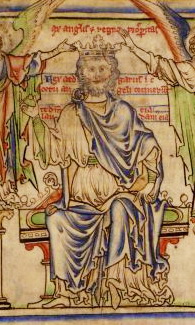It was on July 8th 975 that there occurred the death of King Edgar. Allowing for the shift from the Julian to the Gregorian calendar in 1752 the exact anniversary can therefore be held to fall today.
Image: Wikipedia
The death of King Edgar 1040 years ago is important for two reasons.
His reign is important for his consolidation of what may well be described as an imperial kingship - something his uncle King Athelstan had developed in his reign between 924 and 939 as he expanded his realm - and most notably by his coronation in 973 at the abbey in Bath. This was fourteen years after his accession - though he may have had a coronation at that time - and took place when he had reached the age of ordination and took place on Whit Sunday. This was sacral kingship, celebrated in a Roman spa town, analogous to Charlemagne's Aachen. The Rite used in 973 remains the basis of the English Coronation ceremony, used most recently for the present Queen in 1953, 980 years later.
The King's subsequent visit to Chester where he was ceremonially rowed along the river Dee from the city to St John's church by several tributary kings became celebrated as an assertion and exemplification of English hegemony over Britain,
Described in the early twelfth century as having been "extremely small both in stature and bulk" by that, careful historian William of Malmesbury he was anything but slight in importance as a monarch and as a key figure in the development of the institution of the monarchy and of monasticism, exemplified in the Regularis Concordia of 973, to which there is an introduction here.
The sacrality of King Edgar's monarchy is recalled in this thirteenth century illumination in an anonymous Life of King Edward the Confessor
Cambridge University Library, MS Ee.3.59: fol. 3v
The King's subsequent visit to Chester where he was ceremonially rowed along the river Dee from the city to St John's church by several tributary kings became celebrated as an assertion and exemplification of English hegemony over Britain,
Described in the early twelfth century as having been "extremely small both in stature and bulk" by that, careful historian William of Malmesbury he was anything but slight in importance as a monarch and as a key figure in the development of the institution of the monarchy and of monasticism, exemplified in the Regularis Concordia of 973, to which there is an introduction here.
King Edgar seated between St Æthelwold and St Dunstan. From an eleventh-century manuscript of the Regularis Concordia
British Library, Cottonian MS Tiberius A III, f2v
Image: Wikipedia
There is an online account of his reign at Edgar the Peaceful, which has a bibliography of recent studies of the reign. The Oxford DNB life by Ann Williams can be accessed here and provides a more detailed and academic account.
The sacrality of King Edgar's monarchy is recalled in this thirteenth century illumination in an anonymous Life of King Edward the Confessor
Cambridge University Library, MS Ee.3.59: fol. 3v
Image: Wikipedia
The second reason for the significance of the death of King Edgar was that it brought about the accession of his elder son as King Edward, who was to go down in history as the Martyr, he appears to have been illegitimate or of doubtful legitimacy, and only a boy or teenager at the time. His murder three years later and replacement by his younger, legitimate half-brother King Æthelred II, seemingly with the involvement of the new king's mother, set in motion those elements of instability and lack of political legitimacy that were to haunt King Æthelred the Unready [Unraed signifying No Counsel, a pun on his name which means Good Counsel] and his reign.
There is an online account at of King Edward the Martyr at Edward the Martyr, and the Oxford DNB life, by Cyril Hart can be seen at Edward [St Edward; called Edward the Martyr] (c.962–978); this again provides a more detailed account of his life and reign.
King Edgar died at Winchester, but he was not buried there with so many of his family, but at the abbey at Glastonbury. The abbot was St Dunstan, who as Archbishop of Canterbury was a major player in the King's reign, and the compiler and celebrant of the 973 coronation. By choosing to be buried at Glastonbury - and it seems right to assume that the King did that - he maintained his identification with the Dunstanian monastic reform and confirmed its alliance with the monarchy.
There appears to have developed something of a cult around King Edgar at Glastonbury, and on the eve of the dissolution of the abbey Under the last two abbots the Edgar Chapel was built on to the east end of the monastic church to contain his remains.

Reconstruction model of Glastonbury Abbey on the eve of the dissolution.
The Edgar Chapel is on the extreme left.
Image:skyscrapernews.com/All rights reserved. Copyright Holder - GNU License





No comments:
Post a Comment